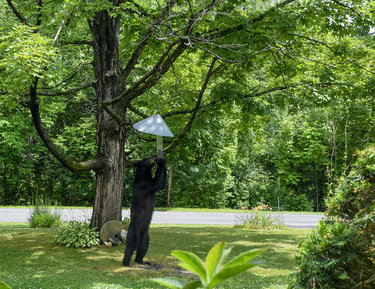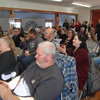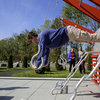Black bear encounter was ‘a wonderful, exciting experience’
KNOX — “I let out a big scream,” said Wanda Gardner.
The big scream followed her seeing a big black bear outside her kitchen window. The bear was standing on its hind legs to pillage seed from the Gardners’ bird feeder.
Jim Gardner, publisher emeritus of The Enterprise, and his wife, Wanda, live on a wooded side road in Knox.
They are well aware that food left outdoors can attract bears and meticulously bring in their bird feeders every night, putting them out again each morning.
Wanda named some of the many birds they watch at their feeders — cardinals, goldfinches, nuthatches, and blue jays among them.
Jim is handy with a camera after decades of taking, developing, and printing pictures for The Enterprise. He uses his 33-millimeter Nikon with a zoom lens to record birds at their feeders and other natural wonders in their yard, displaying the pictures in an annual calendar.
“I was yelling for it to go away,” said Wanda of the bear that was making an unusual afternoon visit on July 12. “I called for Jim. He went and got his camera,” she said.
Jim, who grew up hunting and fishing, reads a lot of outdoor and sporting magazines.
“They constantly have articles about people encountering bears,” Jim said.
From his reading, he said, he has created his own protocol on what to do when encountering a bear — chiefly, avoid acting aggressive, moving quietly and slowly.
Jim is an avid deer and pheasant hunter but has never hunted bears. He has seen bears quite a few times over the years while fishing and even in his own yard.
Earlier this spring, he was up just as it was getting light out when the motion detector in front of the kitchen door was activated.
“He was looking right up at me through the window,” Jim said of the springtime bear, wondering if it was the same one who visited on July 12.
Camera in hand on the 12th, he carefully maneuvered to the deck to photograph the bear at the bird feeder. “The bear showed no aggression whatsoever,” Jim said. “He stared right at me.”
Looking through his camera’s lens, he saw the bear climb the old sugar maple from which the feeder hung. The bear sat on a head-high limb above the feeder and tried to reach it but couldn’t.
“He thought, ‘Ooops, this isn’t going to work,’” said Jim, channeling the bear, which he estimated weighed about 200 pounds. The bear climbed back down.
After the bear had had its fill and left, Jim found another of their birdfeeders about 100 feet away in a small clearing in the brush and deduced the bear had gotten to it earlier that day.
He called the encounter “a wonderful, exciting experience” and anticipates the bear will appear in next year’s calendar.
Official advice
The state’s Department of Environmental Conservation estimates there are a minimum of 6,000 to 8,000 black bears (Ursus americanus) in areas open to hunting across New York state with 50 to 60 percent in the Adirondacks, 30 to 35 percent in the Catskills, and 10 to 15 percent in the state’s central-western region.
While bears are “rarely seen” by most New Yorkers, the DEC says, “Many people enjoy just knowing that bears are present in New York. For many, black bears symbolize wilderness and wildness, but increasingly, bears can be found in semi-rural environments, agricultural areas, and occasionally in urban centers.”
An average adult male black bear weighs about 300 pounds while a female averages about 170 pounds. They hibernate for up to five months in the winter.
Bears are omnivorous and eat nearly anything, the DEC says, noting they are curious and intelligent, learning from experience.
“If an activity results in food, they will repeat that activity,” the agency says. “If an encounter with a human is negative, they learn to avoid humans. Also if an encounter with a human doesn’t result in a reward (food), they will not have any reason to have contact with humans.”
The DEC advice goes on, “When bears learn to obtain food from humans, they can become bold and aggressive. Deliberate and intentional feeding of bears is illegal in New York.”
It also stresses, “Feeding bears is bad for bears — Bears’ natural foraging habits and behavior can be changed. Usually solitary, bears can be concentrated in areas causing stress, injuries from physical conflicts, and the spread of diseases. Often when feeding on garbage or camper’s supplies, bears will eat unhealthy materials such as soap, shaving cream, insect repellant, food packaging, etc.”
The DEC has partnered with BearWise, a national program of the Association of Fish and Wildlife Agencies, to provide reliable information and useful resources that help people live responsibly with black bears.
On bird feeders, for example, BearWise notes that birdseed is attractive to bears because of the high calories and recommends not putting out bird feeders during the months bears are active; rather, putting them out only during the months when bears are hibernating.
It suggests other ways to attract birds, not bears, to yards such as bird baths and sand baths, perches, or bird houses. Also, citing the Audubon Society’s Native Plants Database, BearWise recommends planting native plants, flowers, bushes, vines, trees and evergreens to provide birds with food and shelter from predators and bad weather. Brightly colored, trumpet-shaped and tubular flowers attract hummingbirds, it says, while sunflowers, coneflowers, asters and marigolds all produce seeds birds like to eat.
These prevention strategies are listed as BearWise Basics, with details available by clicking:
— Never feed or approach bears;
— Secure food, garbage and recycling;
— Remove bird feeders when bears are active;
— Never leave pet food outdoors;
— Clean and store grills and smokers; and
— Alert neighbors to bear activity
Although black bears have a natural fear of humans, they can act or become defensive if surprised, approached, or become emboldened by human food sources, the BearWise webpage says.
On bear encounters, it says never to run from a bear or approach a bear; rather, move quietly away. If you encounter a bear in your backyard, it says, “From a safe distance, make loud noises, shout, or bang pots and pans together to scare away the bear.”
These are listed as BearWise safety tips:
— What to do and how to behave if you see a bear;
— How to keep bears out of homes and businesses;
— How to keep your dog safe in bear country;
— How to hike, camp, and fish safely in bear country;
— How to hunt safely in bear country;
— How to have a bear-safe vacation;
— How to protect your livestock, bees, crops, and orchards from bears; and



